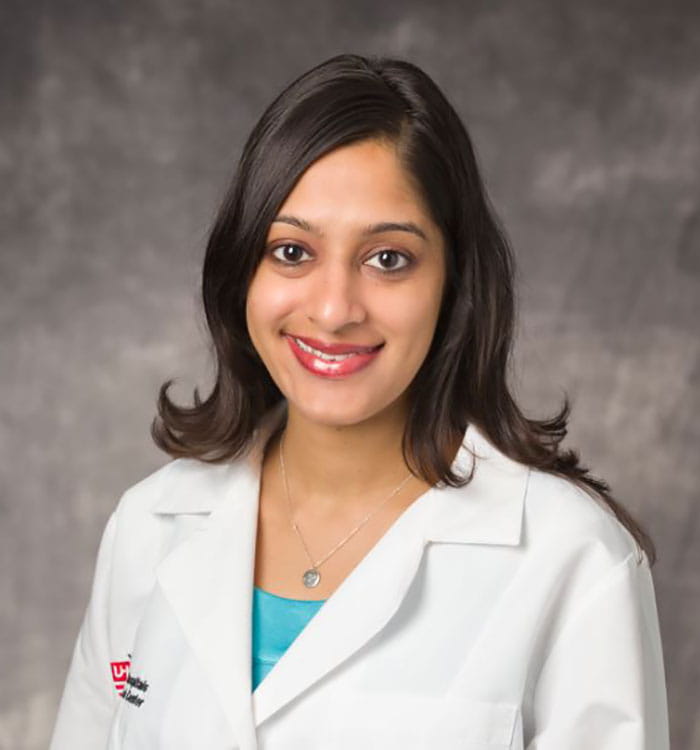The Right Dose, at the Right Time, for the Right Duration
October 05, 2021
Ankita Desai, MD, New Division Chief of Pediatric Infectious Disease and a recent “Dinner with the Doc” winner, has led the UH Rainbow Antimicrobial Stewardship Program to national recognition
UH Clinical Update | October 2021
Infections that are resistant to antibiotics and other antimicrobials remain an extremely challenging problem in healthcare. The Centers for Disease Control and Prevention estimates that each year, 2.8 million people develop an antibiotic-resistant infection, resulting in more than 35,000 deaths.
 Ankita Desai, MD
Ankita Desai, MD.One proven solution to this issue that has emerged in recent years is a coordinated antimicrobial stewardship program at the hospital level. These programs work hand in hand with providers to promote the selection of the optimal antimicrobial drug regimen, dose, duration of therapy and route of administration.
Here at UH, the program of this type in place at UH Rainbow Babies & Children’s Hospital just was recognized as one of the best in the country. It was designated as a Center for Excellence in Antimicrobial Stewardship by the Infectious Disease Society of America.
Ankita Desai, MD, recently named Division Chief of Pediatric Infectious Diseases at UH Rainbow, has led the antimicrobial stewardship program here since her arrival at UH in 2013. She says she and a dedicated antimicrobial stewardship pharmacist, LeAnne Moore, PharmD, have used a variety of tactics to achieve these encouraging results.
“Together we were able to create guidelines in our institution,” she says. “We started prospective monitoring of antibiotic prescribing, providing feedback to providers. We look at all IV antibiotics that are prescribed and assess them for appropriateness and reach back out to the provider to say whether it is correct, or whether they can use a different agent or a different dosing regimen. Right when it’s ordered, each morning LeAnne looks at everybody’s antibiotic orders at UH Rainbow.”
Beyond this process change, Dr. Desai and her team have also restricted ordering of some antibiotics on the UH Rainbow formulary, those that she says are considered the “big guns.”
Dr. Desai says her colleagues at UH Rainbow have embraced these changes, welcoming the opportunity to take advantage of the infectious disease expertise present in the division.
“Over time, it has just became part of the culture,” she says. “Everyone knew what we did. Instead of being seen as people who were telling you what to do, we were all part of a team. We’re able to work together. Now we work very closely with the neonatologists and the intensive care unit and hematology/oncology, where antibiotics are used extremely commonly, working hand in hand in making guidelines and helping appropriately prescribe the right antibiotic.”
In recognition of this work, Dr. Desai was recently honored by UH CEO Cliff Megerian, MD, with a “Dinner with the Doc” award.
One early success in the antimicrobial stewardship program at UH Rainbow, Dr. Desai says, was decreasing the number of days of therapy on vancomycin.
“This ultimately led to less use of those broad-spectrum antibiotics and in turn, less risk of adverse events, less need to monitor kidney function, and ultimate cost savings,” she says. “We’re using the antibiotic less and there’s also less laboratory monitoring. C. diff rates are linked to broad spectrum antibiotic use. When you decrease your broad spectrum antibiotic use, you keep your C. diff rates steady.”
Although much of the antimicrobial stewardship team’s work at UH Rainbow has gone on within the four walls of the hospital at main campus, the team has also worked in significant ways with primary care pediatricians out in Northeast Ohio communities. They’ve produced therapeutic guidelines for managing common infectious diseases in children, such as otitis media, sinusitis and pneumonia – guidelines that are now used throughout the UH system. They’ve also created infectious disease scorecards so pediatricians can gauge whether their antibiotic prescribing is conforming with guidelines and how it compare with their peers, both within their practice and within the UH system as a whole.
“People have reacted favorably to this,” Dr. Desai says. “They appreciated getting that feedback on their antibiotic use. Our next step now is to turn that into even more meaningful feedback. We’re working on enhancing the feedback to a dashboard that people can access it in real time.”
Another project in the work is a penicillin challenge program aimed at getting a more accurate idea of how many children are truly allergic to penicillin. Dr. Desai says that while 10% of people report having a penicillin allergy, fewer than 1% are truly allergic. This, in turn, unnecessarily cuts them off from a whole family of preferred first-line antibiotics.
“If we think it’s not a true allergy – it might have been mild, or it might have been many years ago and it might not be accurate anymore, we’ve created an algorithm to do an oral challenge while they’re here,” she says. “Then we can de-label them as allergic to amoxicillin, allowing them to proceed with the appropriate penicillin therapy. Many of those agents in that family are often first-line therapies, so patients who have an allergy to those may be getting suboptimal antibiotics.”
Dr. Desai says she looks forward to continuing these and other projects, looking for new ways to maintain antibiotics and other antimicrobials the most effective against the pathogens that cause disease. It’s an interest that dates back to her undergraduate course in microbiology, which was her favorite.
“Certain times things are overwhelming, like in a pandemic, but it’s really one of the most rewarding fields because I feel like we’re detectives,” she says. “When we figure out what it is, we can target therapy to the most appropriate thing and make sure patients are getting the right antibiotic that they need. It’s really satisfying.”
Congratulations to Dr. Desai on her “Dinner with a Doc” award.
To nominate a UH physician caregiver for this award, please visit https://uhcommunity.uhhospitals.org/News/Documents/Cliff_Appreciates_Dinner_w_Doc_Nomination_Form-_FINAL.pdf.
The next deadline is Nov. 5.


